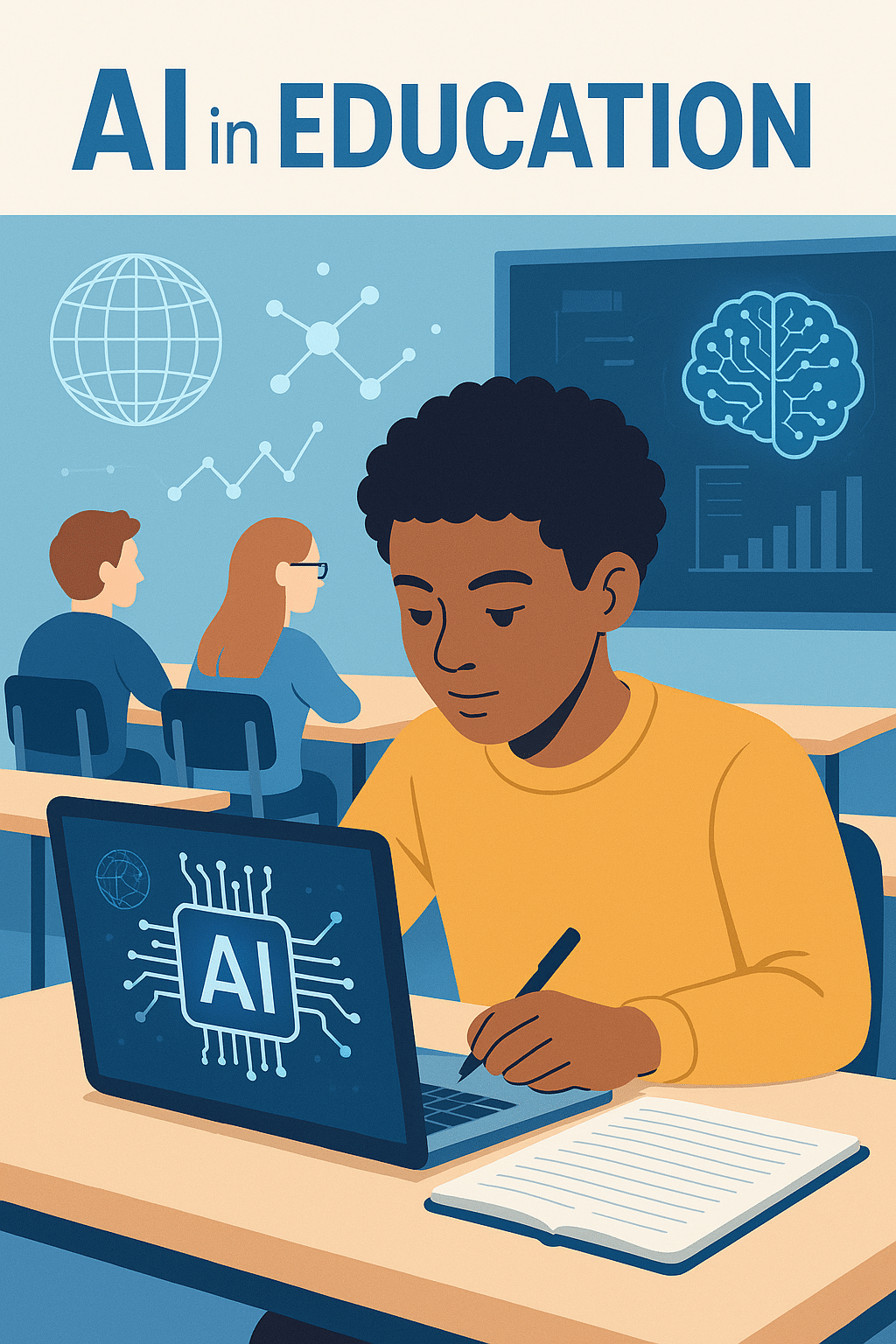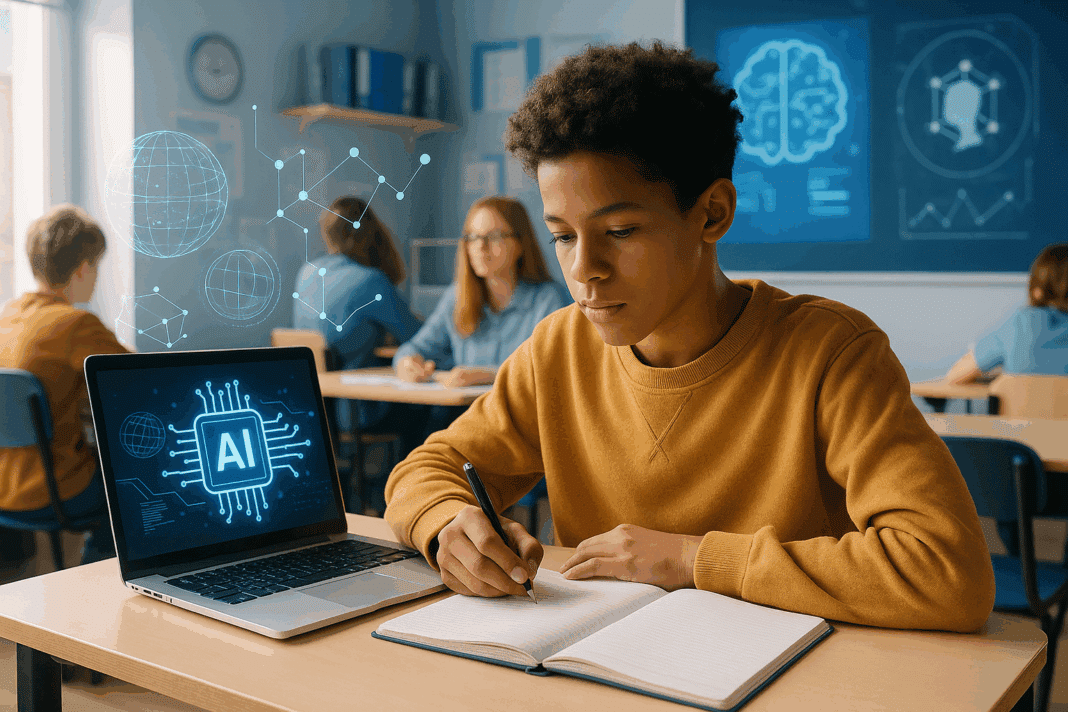The Future of AI-Powered Education: How Robots and Algorithms Are Entering Classrooms
AI in education is revolutionizing how students learn and teachers teach. In the near future, AI in education will power personalized lessons, smart classrooms, and even robot assistants. Schools are increasingly adopting digital learning tools powered by artificial intelligence in schools, making smart classrooms a reality. This article examines how robots and AI algorithms are entering classrooms, enhancing learning and teaching.
Rise of AI in Education
AI and algorithms are transforming traditional classrooms into high-tech learning environments. Governments and educators are investing in edtech to support teachers and engage students. For example, AI can automate routine tasks (attendance, grading, paperwork), freeing teachers to focus on instruction. As UNESCO and education experts note, AI in education can âstreamline administrative tasksâ and âtailor learning to the individualâ. Smart whiteboards, interactive apps, and data analytics are becoming common. In fact, AI systems already analyze student performance to recommend resources, embodying the digital learning trends of today.
AI-Powered Teaching Tools
AI-powered tools like virtual tutors and content generators are emerging. For instance, Khan Academyâs Khanmigo is an AI tutor that can help students solve math problems and even draft essays. Teachers can prompt Khanmigo to generate lesson plans and activities, reducing their workload. Language apps use AI tutors as well: Duolingoâs âLilyâ chatbot lets users practice conversation in foreign languages. These AI tools offer one-on-one assistance at scale. In essence, edtech companies are building algorithms that act like robotic teaching assistants, guiding students through lessons and giving instant feedback.
Personalized Learning and Adaptive Education
A key advantage of AI in education is personalized learning. AI systems adapt to each studentâs pace and style. Researchers have found that individualized tutoring can lead to dramatic improvements in learning outcomes; in fact, tutored students outperform 98% of peers in traditional settings. AI promises to bring this level of personalization to all students. For example, platforms can adjust the difficulty of questions in real time or recommend extra practice where needed. This smart classroom approach helps ensure that every learner has a customized path to success. As WEF reports, harnessing AI allows educators to âtailor the learning experience to the individualâ.
Robots and Smart Classrooms
Beyond software, robots in classrooms are appearing worldwide. Some schools use social robots to help children with special needs engage and communicate. While large humanoid robots (like Pepper) have been tested in education, many applications focus on smart infrastructure: voice-activated devices, AI-powered microscopes, and AR/VR labs. Smart sensors adjust lighting and climate for comfort, and collaborative robots can even help in science labs. These innovations illustrate the rise of smart classrooms where AI and physical devices work together. Even modest examplesâsuch as AI monitoring to detect when students raise handsâare demonstrating how technology can augment teaching.

Benefits of AI in the Classroom
Overall, AI offers numerous benefits for education. It can automate grading and plagiarism detection, giving teachers more time to mentor students. AI analytics can highlight when a student is falling behind, enabling early intervention. Students get rapid, personalized feedback from AI tutors. As reported by ASU Prep Global, âAI in education offers numerous benefits, including automating time-consuming tasks such as grading and plagiarism detection⦠[and] AI tools also provide personalized feedback and enhance student engagementâ. Early trials of AI tools indicate students become more confident learners when supported by AI. For example, one study suggests AI tutors could be an affordable alternative to expensive private tutors.
Challenges and Ethical Considerations
Despite the promise, AI in education raises concerns. Educators warn against overreliance on technology: teachers must always review AI-generated content for accuracy and appropriateness. In special education, experts emphasize that âteachers need to review AIâs suggestions carefullyâ and protect student privacy. AI systems require vast student data, so data protection and bias are issues. There is also concern about job displacement, though many see AI as a tool, not a replacement, for teachers. Ensuring equitable access is critical; otherwise AI in schools could widen gaps. Finally, ethical use of AI (transparency, consent, fairness) must guide implementation. As one educator notes, AI should not be seen as a âmagical toolâ and schools should teach AI literacy to all.
Mini-FAQ
- Q: What is AI in education?
A: AI in education refers to using artificial intelligence to support teaching and learning, such as personalized tutoring systems and automated grading. - Q: How are robots being used in schools?
A: Some schools use social robots to assist learning (especially for special needs), and smart classroom devices (like voice-activated assistants) help teachers manage lessons. - Q: Are AI tutors effective for students?
A: Early evidence suggests AI tutors can improve learning; research shows students receiving individualized tutoring outperform 98% of peers, and AI tutors like Khanmigo offer scalable support. - Q: What is a smart classroom?
A: A smart classroom integrates technology like interactive boards, sensors, and AI software. It adapts to student needs and automates admin tasks, creating an optimized learning environment. - Q: How does AI personalize learning?
A: AI analyzes a studentâs performance and tailors content. For example, adaptive platforms adjust difficulty in real-time and recommend specific exercises, ensuring each student learns at their own pace.
Conclusion
AI-powered education is rapidly evolving. From digital learning platforms to classroom robots, AI tools are enhancing teaching and learning. Students can benefit from personalized tutoring and engaging smart lessons, while teachers gain valuable time and insights. However, responsible use is key: educators must guide AI use and protect student data. As edtech advances, artificial intelligence in schools will likely become standard, reshaping education for the better.
Further Reading
- UNESCO: Artificial Intelligence in Education
Insights and policy guidelines on how AI is reshaping classrooms worldwide.
ð unesdoc.unesco.org - World Economic Forum: How AI is Changing Education
Analysis on adaptive learning, smart classrooms, and ethical concerns.
ð weforum.org - Brookings Institution â AI and the Future of Learning
Research on AI tutors, automation in schools, and the role of teachers in AI-driven systems.
ð brookings.edu - EdSurge: Classroom Robots and AI Teaching Tools
Case studies on real-world use of robots and AI tutors in schools.
ð edsurge.com - MIT Technology Review: The Promise and Risks of AI in Education
Balanced look at how AI can personalize learning while raising ethical questions.
ð technologyreview.com

